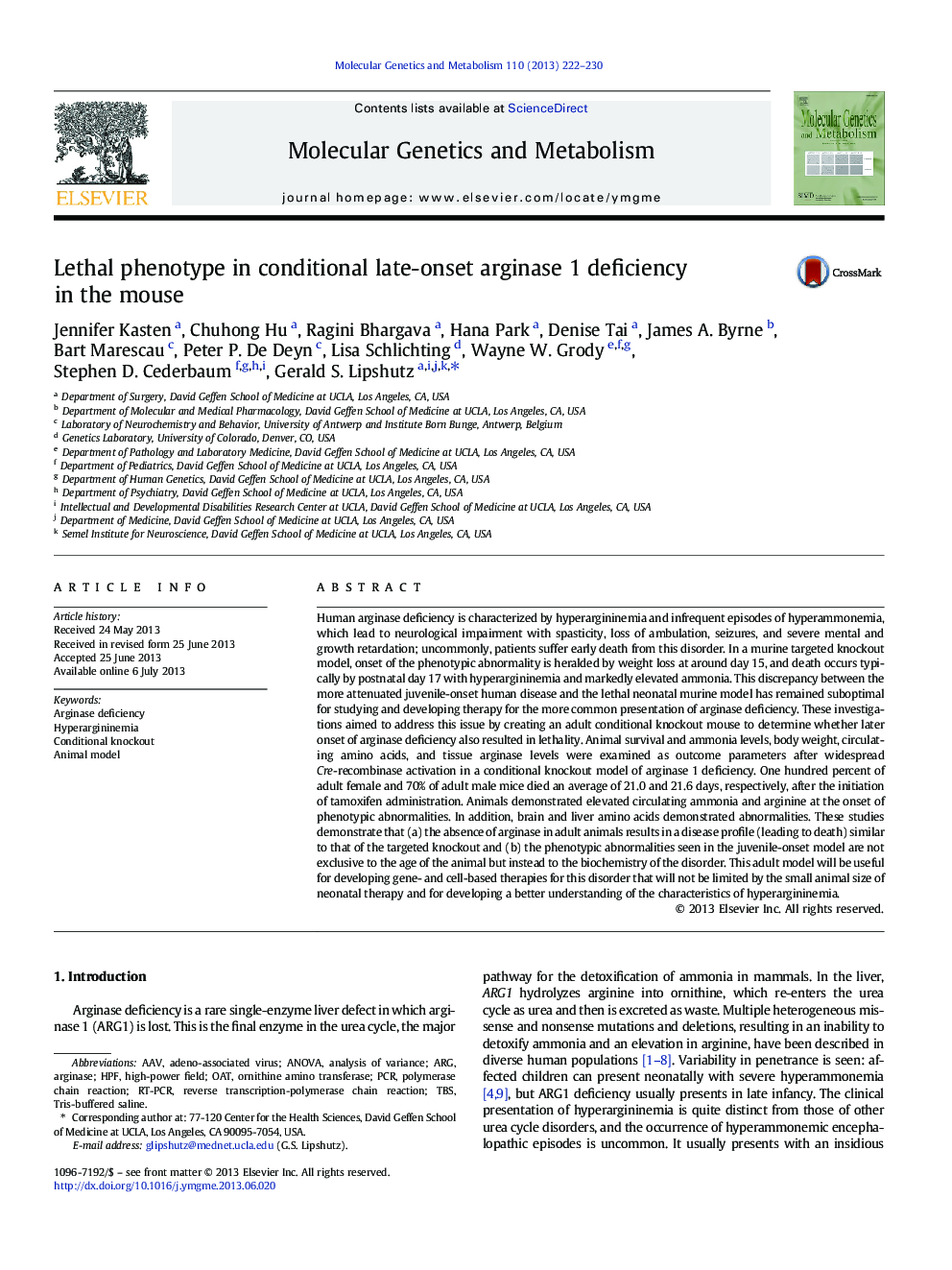| کد مقاله | کد نشریه | سال انتشار | مقاله انگلیسی | نسخه تمام متن |
|---|---|---|---|---|
| 10833178 | 1065789 | 2013 | 9 صفحه PDF | دانلود رایگان |
عنوان انگلیسی مقاله ISI
Lethal phenotype in conditional late-onset arginase 1 deficiency in the mouse
ترجمه فارسی عنوان
فنوتیپ مرگبار در کمبود آرژنین 1 در موش صحرایی دچار مشکوک
دانلود مقاله + سفارش ترجمه
دانلود مقاله ISI انگلیسی
رایگان برای ایرانیان
کلمات کلیدی
arginase deficiencyhyperargininemiaAAVTBSRT-PCRhpfArginase - آرژینازArg - ارگanalysis of variance - تحلیل واریانسANOVA - تحلیل واریانس Analysis of varianceTris-buffered saline - تریس بافر شورOat - جو دو سرconditional knockout - شکستن شرطAnimal model - مدل حیوانیhigh-power field - میدان قدرت بالاreverse transcription-polymerase chain reaction - واکنش زنجیره ای رونویسی-پلیمراز معکوسpolymerase chain reaction - واکنش زنجیره ای پلیمرازPCR - واکنش زنجیرهٔ پلیمرازAdeno-associated virus - ویروس Adeno مرتبط است
ترجمه چکیده
کمبود آرژنین انسانی به وسیله هیپرگرگینینمی و موارد نادری از هیپرامونمی مشخص می شود که منجر به نقص عصبی با اسپاستیک، از دست دادن زوال، تشنج و شدید عقب ماندگی ذهنی و رشد می شود. غالبا، بیماران دچار مرگ زودرس از این اختلال می شوند. در یک مدل قهرمانانه هدفمند قارچی، شروع اختلال فنوتیپی با کاهش وزن در حدود روز 15 به وقوع پیوسته و مرگ و میر به طور معمول در روز 17 پس از زایمان با هیپرژژینینمی و به طور قابل توجهی افزایش آمونیاک رخ می دهد. این اختلاف بین بیماری های مبتلا به مبتلا شدن به بیماری های مبتنی بر نوجوان کمتر و مدل موش های کشنده نوزادان هنوز برای مطالعه و توسعه درمان برای ارائه شایع تر از کمبود آرژیناز باقی مانده است. این تحقیقات به منظور حل این مسئله با ایجاد یک موش صحرایی بالغ بالغ برای تعیین اینکه آیا بعد از شروع کمبود آرژنین نیز باعث مرگ و میر شد. بقای حیوانات و سطوح آمونیاک، وزن بدن، اسیدهای آمینه اسیدهای وریدی و سطوح آرگانیاز بافت به عنوان پارامترهای نتیجه پس از فعال شدن کرم-کمکی بیضه در یک مدل ناخوشایند شرطی کمبود آرژنین 1 مورد بررسی قرار گرفت. 100 درصد از زنان بالغ و 70 درصد موش های نر بالغ به طور متوسط بعد از شروع تزریق تاموکسیفن به ترتیب 21 و 21.6 بار در روز مرده اند. حیوانات در هنگام شروع اختلالات فنوتیپی، آمونیاک و آرژنین افزایش یافتند. علاوه بر این، اسیدهای آمینه مغز و کبد، اختلالات را نشان می دهد. این مطالعات نشان می دهد که (الف) عدم وجود آرژیناز در حیوانات بالغ منجر به یک مشخصات بیماری (منجر به مرگ) مشابه با نابودی هدفمند و (ب) ناهنجاری های فنوتیپی دیده شده در مدل مبتنی بر نوجوانان منحصر به سن حیوانات اما به جای بیوشیمی از اختلال. این مدل بزرگسالان برای توسعه درمان های مبتنی بر ژن و سلول برای این اختلال مفید خواهد بود که توسط اندازه کوچک حیوانات نوزادان محدود نمی شود و برای درک بهتر ویژگی های هیپرگرگینینمی محدود نمی شود.
موضوعات مرتبط
علوم زیستی و بیوفناوری
بیوشیمی، ژنتیک و زیست شناسی مولکولی
زیست شیمی
چکیده انگلیسی
Human arginase deficiency is characterized by hyperargininemia and infrequent episodes of hyperammonemia, which lead to neurological impairment with spasticity, loss of ambulation, seizures, and severe mental and growth retardation; uncommonly, patients suffer early death from this disorder. In a murine targeted knockout model, onset of the phenotypic abnormality is heralded by weight loss at around day 15, and death occurs typically by postnatal day 17 with hyperargininemia and markedly elevated ammonia. This discrepancy between the more attenuated juvenile-onset human disease and the lethal neonatal murine model has remained suboptimal for studying and developing therapy for the more common presentation of arginase deficiency. These investigations aimed to address this issue by creating an adult conditional knockout mouse to determine whether later onset of arginase deficiency also resulted in lethality. Animal survival and ammonia levels, body weight, circulating amino acids, and tissue arginase levels were examined as outcome parameters after widespread Cre-recombinase activation in a conditional knockout model of arginase 1 deficiency. One hundred percent of adult female and 70% of adult male mice died an average of 21.0 and 21.6Â days, respectively, after the initiation of tamoxifen administration. Animals demonstrated elevated circulating ammonia and arginine at the onset of phenotypic abnormalities. In addition, brain and liver amino acids demonstrated abnormalities. These studies demonstrate that (a) the absence of arginase in adult animals results in a disease profile (leading to death) similar to that of the targeted knockout and (b) the phenotypic abnormalities seen in the juvenile-onset model are not exclusive to the age of the animal but instead to the biochemistry of the disorder. This adult model will be useful for developing gene- and cell-based therapies for this disorder that will not be limited by the small animal size of neonatal therapy and for developing a better understanding of the characteristics of hyperargininemia.
ناشر
Database: Elsevier - ScienceDirect (ساینس دایرکت)
Journal: Molecular Genetics and Metabolism - Volume 110, Issue 3, November 2013, Pages 222-230
Journal: Molecular Genetics and Metabolism - Volume 110, Issue 3, November 2013, Pages 222-230
نویسندگان
Jennifer Kasten, Chuhong Hu, Ragini Bhargava, Hana Park, Denise Tai, James A. Byrne, Bart Marescau, Peter P. De Deyn, Lisa Schlichting, Wayne W. Grody, Stephen D. Cederbaum, Gerald S. Lipshutz,
